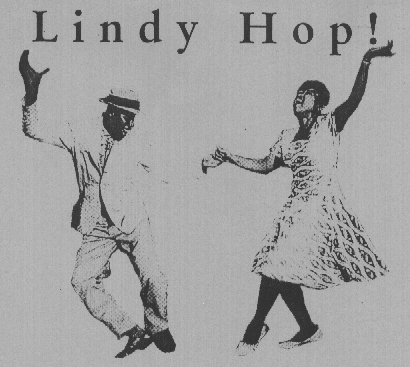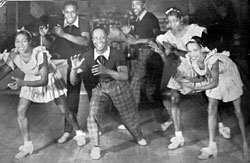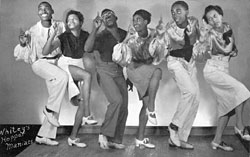What is Lindy Hop?
 Lindy Hop, also known as Jitterbug, is the authentic Afro-Euro-American Swing dance. It is an unabashedly joyful dance, with a solid, flowing style that closely reflects its music -- from the late 20's hot Jazz to the early 40's Big Bands. Just as Jazz combines European and African musical origins, Lindy Hop draws on African and European dance traditions. The embracing hold, and the turns from Europe, the breakaway and solid, earthy body posture from Africa. The dance evolved along with the new swing music, based on earlier dances such as the Charleston and the Black Bottom, by black people in Harlem.
Lindy Hop, also known as Jitterbug, is the authentic Afro-Euro-American Swing dance. It is an unabashedly joyful dance, with a solid, flowing style that closely reflects its music -- from the late 20's hot Jazz to the early 40's Big Bands. Just as Jazz combines European and African musical origins, Lindy Hop draws on African and European dance traditions. The embracing hold, and the turns from Europe, the breakaway and solid, earthy body posture from Africa. The dance evolved along with the new swing music, based on earlier dances such as the Charleston and the Black Bottom, by black people in Harlem. Lindy Hop is a social dance. Partners are connected smoothly and gently to each other, while relating closely to the music, in feeling, improvisation and phrasing. The core tempo range is 120-180 beats per minute.
Films such as Hellzapoppin and Day at the Races, as well as Malcolm X and Swingkids show seemingly reckless airsteps (aerials), often done at very fast musical tempos. Far from being just acrobatic antics, airsteps are in fact smooth, extremely precise, and perfectly in synch with the music. They require a superb degree of expertise and are not danced socially, but only for performance, if only inside a protective ring of spectators, as in the Cats' Corner jams at the Savoy Ballroom. Airsteps are impressive and spectacular, so that's what you see in the movies!
Savoy style Lindy Hop, as taught by Frankie Manning and Steven Mitchell, has the lightest, gentlest, and smoothest connection of all the common Swing dances! It is solid, low, relaxed and energetic.
Looking back on where the Lindy Hop came from is an amazing study of American history and of the global cultural shift facilitated by the American GI's that traveled in World War II.
The influences of the Charleston and Tap dance are evident still in the Lindy we do today and the dance is also sited to have come from an early version of the Foxtrot. Remnants of older dancers such as the Cakewalk, Texas Tommy, Black bottom and popular "animal" dances such as the Turkey Trot and the Buzzard Lope are also expressed. What is interesting is that these came from African social dance culture, and some, like the Cakewalk was created when blacks imitated and mocked the formal dance structure of the whites, which they would then use in their entertainment routines. Ironically, the white spectators would then copy the entertainers, and a social dance that bridged the divide emerged.
Luckily, the two cultures found a common ground, called the Savoy Ballroom in New York. It was here that Lindy was fine tuned and grounded, and where the "Savoy style" that was to influence the world grew up.
The Savoy Ballroom
 | |
| The Savoy Ballroom | |
The Coat check could serve up to 5,000 patrons, and it needed to, with 70,000 patrons a year dancing at the "home of happy feet". The sprung floor was replaced every 3 years and came to be known as "the Track" due to its elongated shape. The bandstand at each end accommodated two live bands every night, 7 nights a week.
Jazz was in its heyday, since a night out dancing was cheap, and recorded music was not yet readily assessable. Names such as Cab Calloway, Duke Ellington and Count Basie made music history in the battle of the bands held there. The players would feed off the dancer's improvisation as much as the dancers fed off the music. The atmosphere of the Ballroom must have been electric as the top dancers would meet in "Kats Corner" and take turns to show off and play with the rhythms. Weekly competitions promoted friendly rivalry between dance troupes and dancers were inspired to create new, more exciting moves to wow the crowd and win over the judges. Audiences were amazed to sight the first Aerial move (or airstep) created by Frankie Manning and his partner Freda Washington for these competitions.
 | |
| Shorty 'George' Snowden | |
The atmosphere at the Savoy permitted a situation that was ripe for dancers to perfect their craft, and for something spectacular to come from The Savoy…
Whitey's Lindy Hoppers
 | |
| Whiteys Lindy Hoppers | |
The Lindy then had an audience across the Nation, by which it inspired and influenced other dance styles. And it is this film footage still amazes and inspires the dancers of today.
The Granddaddy of Swing
"Lindy Hop" refers to this particular dance done and Swing was the music they would dance too. The term "Swing" is now commonly used to include many styles of dance: Lindy Hop, Jitterbug, Balboa, Shag, East and West coast swing, Boogie Woogie, and has also inspired Jive, Rock and Roll, Ceroc, Le-Roc with regional differences in each dance family.
Many may say that Lindy Hop was the granddaddy of them all, but that should not imply that no one was dancing any form of Swing before Lindy swept the country. People were already creating dances to their local bands. The variations in the music and the conditions they were dancing in impacted on the dance that was created in that region. The performances that came out of the Savoy Ballroom however, must have rocked their world when they saw them on stage or at the flicks! They only had one chance to see a move before reinventing it for themselves, so the moves would evolve and become something new, and the dances would blend to accommodate the new fashion.
The Jitterbug
One such blending is the Jitterbug, which is so close to the Lindy hop that one might call it the same dance. The Jitterbug though, referred to a different styling, and may also refer to the way the white kids danced the Lindy Hop - as if they had been drinking an illegal moonshine called "Jitter juice". Nowadays, the term Jitterbug can be used to mean different dances in different places, but Lindy Hop still refers to the Savoy Style of dance.
Hollywood Style
 | |
| Dean Collins and Martha Raye from the movie Hellzapoppin (1941) | |
Once in LA, Dean smoothed out the dance and put his own emphasis on it. This lead him to choreograph and perform in many films including "Lets make Music", "Chool Song" and "Buck privates". Dean also broke the dance into teachable components, Arthur Murray being one of his students.
In more recent swing history, Sylvia Sykes and Jonathan Bixby rediscovered Dean Collins, and perfected the art of "smooth style" directly from its master. The swing revival has also prompted Erik and Sylvia Robison to coin the term "Hollywood Style", to refer to the style of dancing seen in movies of the era, including those starring Dean Collins.
The Neo-Swing revival
The original Lindy Hop died off as the music changed to Be-Bop and Rock and Roll. An entertainment tax made live big bands expensive and as recorded music became affordable, dance halls became smaller and more crowded, and the style of dancing had to change to accommodate this.
In the mid 1980's some of the original members were rediscovered by new dancers inspired by their film footage Steven Mitchell & Erin Stevens found Frankie Manning. The Rhythm Hot Shots found Al Minns, and The Jiving Lindy Hoppers found Mama Lu Parks.
Since then, Frankie Manning has come back on the dance scene, teaching new Swing dancers around the globe. The retro dance returned, along with neo-swing bands and vintage fashion. Lindy hit the movies yet again with "Malcolm X", "Swing Kids", "A League of Their Own", "The Mask" and "Swingers". The TV also favoured the new Lindy dancers, with appearances on Ally McBeal and the GAP advert.
Events
Social dancing events run by dancers are diverse and vary in duration, theme and venues between local communities. Social dancing events run by dancers are Diverse and Vary in duration, theme and venues Between local communities. Dancers usually distinguish between regular events or 'after-class' practice sessions, dancing to live bands at 'public' events not run by dancers(known as "Lindy Bombing", in which a group of dancers shows up at an event not originally intended as a dance event) and special 'dances' or the more formal ball . Dancers usually distinguish Between regular events or 'after-class' practice sessions, dancing to live bands at the 'public' events not run by dancers (known as "Lindy bombing", in the which a group of dancers shows up at an event not originally intended as a dance event) and special 'dances' or the more formal ball . Social dancing events may be held as part of a lindy exchange or camp, or be regular parts of the scene's calendar. Social dancing events may be held as part of a Lindy exchange or camp, or be regular parts of the scene's calendar. Live bands frequently provide the opportunities for social dancing in many new or small scenes, and attract groups of dancers attending gigs at local bars or clubs to dance socially. Live bands frequently Provide the opportunities for social dancing in many new or small scenes, and attract groups of dancers attending gigs at local bars or clubs to dance socially.
 Social, dancer-run lindy hop dances are held in a range of spaces, from private parties to church and town halls, bars, gymnasiums, university halls, night clubs, pub function rooms, and any other space with enough room for a dance floor. Social, Lindy hop dancer-run dances are held in a range of spaces, from private parties to church and town halls, bars, gymnasiums, university halls, night clubs, pub function rooms, and any other space with enough room for a dance floor . Individual events may attract anywhere from ten to a thousand dancers, and may run from as little as half an hour to all night. Individual events may attract anywhere from ten to a thousand dancers, and may run from as little as half an hour to all night. Music may be provided by DJs , by live bands, or by music left to play unattended on a sound system, depending on the local scene's conventions and the nature of that particular event. Music may be provided by DJs , live bands by, or by music left to play unattended on a sound system, depending on the local scene's conventions and the nature of that particular event. DJs and bands may play a range of music from the 1920s to today, tending to concentrate on big band music from the 1930s and 1940s. DJs and bands may play a range of music from the 1920s to today, tending to concentrate on big band music from the 1930s and 1940s. Live bands play a wide variety of music for lindy hoppers, from big band standards and blues to original compositions. Live bands play a wide variety of music for Lindy Hoppers, from big band standards and blues to original Compositions. There are ongoing debates about the types of music most appropriate for lindy hop and other swing dances, with the discussions focussing on whether the music should be historically accurate (ie matching a dance style with the popular music of the day) or include other musical styles and forms. There are ongoing Debates about the types of music most Appropriate for Lindy Hop and other swing dances, with the discussions focussing on whether the music should be Historically accurate (ie matching a dance style with the popular music of the day) or include other musical styles and forms.
Social, dancer-run lindy hop dances are held in a range of spaces, from private parties to church and town halls, bars, gymnasiums, university halls, night clubs, pub function rooms, and any other space with enough room for a dance floor. Social, Lindy hop dancer-run dances are held in a range of spaces, from private parties to church and town halls, bars, gymnasiums, university halls, night clubs, pub function rooms, and any other space with enough room for a dance floor . Individual events may attract anywhere from ten to a thousand dancers, and may run from as little as half an hour to all night. Individual events may attract anywhere from ten to a thousand dancers, and may run from as little as half an hour to all night. Music may be provided by DJs , by live bands, or by music left to play unattended on a sound system, depending on the local scene's conventions and the nature of that particular event. Music may be provided by DJs , live bands by, or by music left to play unattended on a sound system, depending on the local scene's conventions and the nature of that particular event. DJs and bands may play a range of music from the 1920s to today, tending to concentrate on big band music from the 1930s and 1940s. DJs and bands may play a range of music from the 1920s to today, tending to concentrate on big band music from the 1930s and 1940s. Live bands play a wide variety of music for lindy hoppers, from big band standards and blues to original compositions. Live bands play a wide variety of music for Lindy Hoppers, from big band standards and blues to original Compositions. There are ongoing debates about the types of music most appropriate for lindy hop and other swing dances, with the discussions focussing on whether the music should be historically accurate (ie matching a dance style with the popular music of the day) or include other musical styles and forms. There are ongoing Debates about the types of music most Appropriate for Lindy Hop and other swing dances, with the discussions focussing on whether the music should be Historically accurate (ie matching a dance style with the popular music of the day) or include other musical styles and forms. Social dances attract dancers from a range of ages and backgrounds, and dress may range from rigorously 'vintage' or historically accurate to a particular 'swing era' (1920s, 30s, 40s, 50s, etc.) to casual sports or street wear, again depending on local culture and the event itself. Social dances attract dancers from a range of ages and backgrounds, and dress may range from rigorously 'vintage' or Historically accurate to a particular 'swing era' (1920s, 30s, 40s, 50s, etc.) To casual sports or street wear, again depending on local culture and the event Itself.
HTML Comment Box is loading comments...
 Happy Valentine's Day
Happy Valentine's Day
 Let's learn to love each other with all your heart ^^
Let's learn to love each other with all your heart ^^


Tidak ada komentar:
Posting Komentar